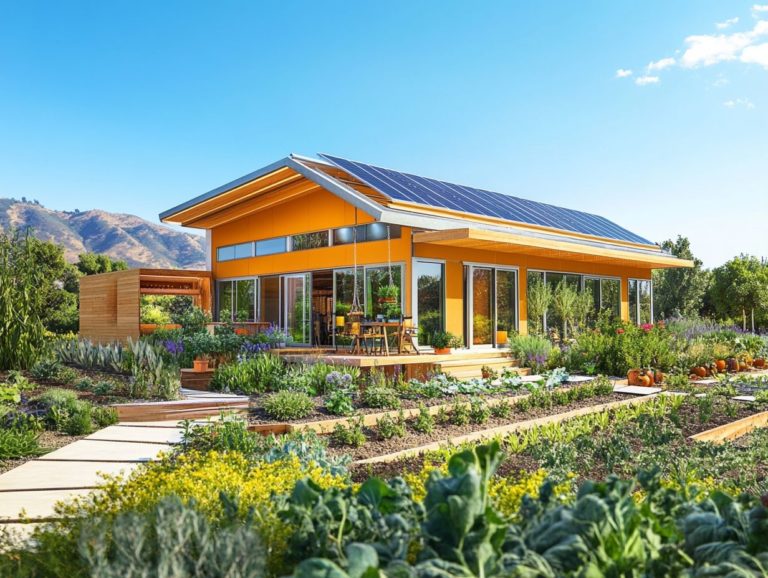The Connection Between Lifestyle and Housing Choices
Choosing a home goes beyond just money; it reflects your lifestyle and personal values.
With options ranging from vibrant urban apartments to tranquil suburban homes, the choices you make can profoundly influence your daily life. This article explores the interaction between lifestyle and housing choices, showing how each shapes the other.
You’ll discover essential factors to consider when selecting a home, explore various housing types, and gather tips for achieving the perfect balance between your lifestyle and housing needs.
Join us as we explore this important aspect of modern living!
Contents
- Key Takeaways:
- Exploring the Relationship Between Lifestyle and Housing Choices
- Factors to Consider When Choosing a Home
- Different Types of Housing Options
- How Lifestyle Can Shape Housing Choices
- Finding the Right Balance Between Lifestyle and Housing
- Frequently Asked Questions
- What is the connection between lifestyle and housing choices?
- How does lifestyle affect housing choices?
- What are some examples of lifestyle factors that impact housing choices?
- Can lifestyle changes lead to changes in housing choices?
- How does the location of a home relate to lifestyle?
- Is there a one-size-fits-all approach to choosing housing based on lifestyle?
Key Takeaways:

Lifestyle can greatly influence housing decisions, as individuals may prioritize certain amenities or locations based on personal preferences and daily routines.
Factors such as location, size, and community play a significant role in choosing a home that aligns with your lifestyle. These should be carefully considered when making a decision.
Finding a balance between lifestyle and housing is key, leading to a more fulfilling and satisfying living situation. Identify what matters most to you and make a decision that fits your unique needs!
Exploring the Relationship Between Lifestyle and Housing Choices
The relationship between lifestyle and housing choices is intricate. Various aspects of your lifestyle influence your housing preferences, guiding your selection of urban settings, suburban neighborhoods, and traditional homes.
Key factors like household composition, occupant behavior, and personal preferences play vital roles in determining the type of house and neighborhood you choose, shaping your quality of life.
Community engagement and local amenities also improve the livability of your residential options. This reflects a broader interaction between lifestyle and housing decisions that deserves careful examination.
The Impact of Lifestyle on Housing Decisions
Your lifestyle shapes your housing choices as you seek to align your living environment with your personal preferences, interests, and aspirations for quality of life.
If you re a single professional, you might prioritize being near urban amenities, favoring neighborhoods filled with nightlife and cultural experiences. Conversely, if you re part of a growing family, your focus may shift toward safety, reputable schools, and spacious homes in quieter suburbs.
If social connections are important to you, you ll likely be drawn to areas with active neighborhood organizations and engaging community events.
Your household composition, including elderly family members or young children, will influence your decisions regarding accessibility and safety features in potential homes.
Ultimately, your choices reflect a commitment to aligning your lifestyle needs with the available housing options.
The Influence of Housing on Lifestyle
Housing plays a pivotal role in shaping your lifestyle, influencing everything from your behavior to your energy consumption and community interactions.
If you live in an urban apartment, you might adopt a fast-paced lifestyle, relying on public transportation and engaging with a diverse mix of neighbors.
In contrast, if you re nestled in the suburbs, larger spaces may encourage outdoor activities and family gatherings, creating a different vibe.
The type of housing you choose can significantly affect your energy consumption. Apartment dwellers often share heating and cooling systems, resulting in lower per capita energy use. Single-family homes tend to consume more energy overall due to their size.
The quality of life you experience can vary greatly depending on community amenities available in your neighborhood. These amenities cater to different preferences, either fostering social connections or promoting a more isolated lifestyle.
Factors to Consider When Choosing a Home
Selecting a home requires careful thought about several key factors that can affect your lifestyle and quality of life.
Consider the location, the convenience of nearby amenities, the size and layout of the house, and the character of the surrounding community.
Each of these aspects shapes your daily experience in your new home.
Location and Proximity to Amenities

Location and access to amenities greatly impact your quality of life and daily routines.
Easy access to public transportation can help you commute efficiently, reducing travel time and stress.
Being close to grocery stores, healthcare facilities, and recreational areas fosters community and encourages social interaction.
This connection supports a balanced lifestyle and allows you to engage with local events and activities.
A well-chosen location can make errands enjoyable, showing how vital good local infrastructure is for a fulfilling life.
Size and Layout
The size and layout of your home are important factors that shape your preferences and quality of life.
An open floor plan encourages social interaction, making it great for families or those who love to entertain.
If you prefer simplicity, a more compact layout may suit you better.
The arrangement of rooms affects functionality; easy access between the kitchen and dining area simplifies meal prep, and well-placed bathrooms can enhance your daily routine.
Outdoor spaces provide opportunities for relaxation, gardening, or recreation, helping you cultivate a lifestyle connected to nature.
These choices create the atmosphere in your home, influencing your activities and long-term satisfaction.
Community and Neighborhood
The community and neighborhood around your home greatly influence your lifestyle and well-being.
In close-knit communities, strong social ties encourage collaboration and support.
These connections foster a sense of belonging crucial for mental health and happiness.
Social indicators, like participation in local events and neighborhood watch programs, reflect a vibrant community spirit.
Access to parks, community centers, and local businesses enhances your quality of life and promotes healthy choices.
Engaging with neighbors leads to shared resources and social events that enrich your life, showcasing the power of community in your lifestyle choices.
Different Types of Housing Options
Explore a variety of exciting housing options, from charming single-family homes to modern townhomes and convenient apartments.
Each option meets different lifestyle preferences and needs, helping you find the perfect fit for your life.
Single-Family Homes
Single-family homes are a popular choice for many individuals and families, aligning with specific lifestyle goals and quality of life factors.
These homes usually provide the space and privacy you want, creating a personal sanctuary away from urban hustle.
With ample square footage, they offer an ideal environment for children, with spaces for play, study, and family gatherings.
The yards that come with single-family homes let you connect with nature, increasing your opportunities for outdoor activities and gardening.
Such settings not only promote a healthier lifestyle but also strengthen family bonds, allowing parents to engage their children in various home activities and build a sense of belonging.
Condos and Townhouses

Condos and townhouses offer a community-focused living experience. They require less maintenance than single-family homes.
These residences are thoughtfully designed with shared amenities like pools, fitness centers, and communal gardens. This creates an inviting atmosphere that encourages a sense of belonging among residents.
They cater to various lifestyles, making them ideal for busy professionals, small families, or retirees who desire a manageable space without compromising comfort.
Both condos and townhouses typically boast strategic locations near urban centers, ensuring easy access to shopping, dining, and entertainment.
This is more than just a home; it s a chance to be part of a lively community that enriches your overall quality of life.
Apartment Living
Apartment living has gained significant traction, especially in urban environments, because of the convenience and access it provides to vibrant, amenity-rich communities.
This lifestyle resonates with those who value being close to work, entertainment, and cultural experiences. It also appeals to individuals seeking a low-maintenance way of life.
While the allure of shared amenities like gyms and pools is undeniable, challenges such as limited personal space and occasional noise from neighbors may arise.
The dynamics within a community can vary greatly, influencing your social interactions and sense of belonging.
By weighing these advantages and challenges, you can make informed decisions about whether apartment living aligns with your lifestyle preferences and social needs.
How Lifestyle Can Shape Housing Choices
Lifestyle plays a crucial role in shaping your housing choices. You prioritize personal preferences that resonate with your aspirations for quality of life and community engagement.
Examples of Lifestyle-Driven Housing Decisions
Examples of housing choices influenced by your way of living vividly illustrate how individual preferences shape your living environments.
For instance, you might be a young professional eager to embrace the vibrancy of a modern apartment in a bustling urban center. You relish the proximity to work, nightlife, and trendy eateries.
In contrast, a family with children may gravitate towards a spacious suburban home, drawn to excellent schools and safe neighborhoods that promise a nurturing environment.
Meanwhile, retirees might seek a tranquil community that offers access to recreational activities and healthcare facilities, reflecting their desire for a peaceful yet engaging lifestyle.
Each choice underscores how personal interests and community features significantly influence where you feel most at home.
Finding the Right Balance Between Lifestyle and Housing
Striking the perfect balance between lifestyle and housing is crucial for attaining an optimal quality of life. This journey calls for smart decisions that can shape your future!
Tips for Making a Decision That Fits Your Needs

Making a decision that truly aligns with your needs demands thoughtful consideration of various factors tied to housing options, lifestyle, and community engagement.
It’s crucial to understand your personal priorities and envision how different environments can enrich your daily life. This includes evaluating your proximity to work, recreational activities, and quality schools if you have children.
Assessing the amenities in potential neighborhoods such as parks, shops, and public transport plays a significant role in shaping your sense of belonging.
Striking a balance between the desire for a spacious home and the reality of a community-centric lifestyle often leads to more fulfilling long-term choices.
Therefore, investing time to explore diverse communities can profoundly enhance your overall quality of life.
Frequently Asked Questions
What is the connection between lifestyle and housing choices?
Lifestyle and housing choices are closely linked. Your personal values and daily habits shape the type and design of your home.
How does lifestyle affect housing choices?
Lifestyle influences housing choices in many ways. It can determine the size, layout, location, and features of a home.
What are some examples of lifestyle factors that impact housing choices?
Common lifestyle factors include income level and family size. Hobbies, work commute, and desired social interaction also play a role.
Can lifestyle changes lead to changes in housing choices?
Absolutely! Lifestyle changes often lead to new housing choices.
For example, getting married, having children, or retiring may prompt you to seek a different type of housing.
How does the location of a home relate to lifestyle?
The location of your home is crucial to your lifestyle. It affects commute times, access to features like parks, shops, and schools, and the neighborhood’s overall culture.
Is there a one-size-fits-all approach to choosing housing based on lifestyle?
No, there isn t a one-size-fits-all approach to housing choices. Each person’s lifestyle and preferences are unique, so the best home for one person may not suit another.






